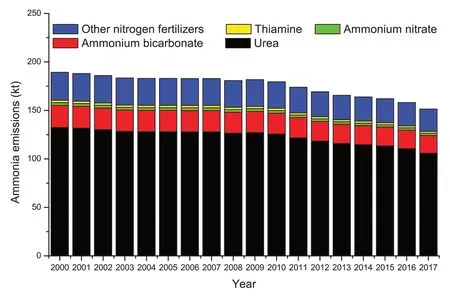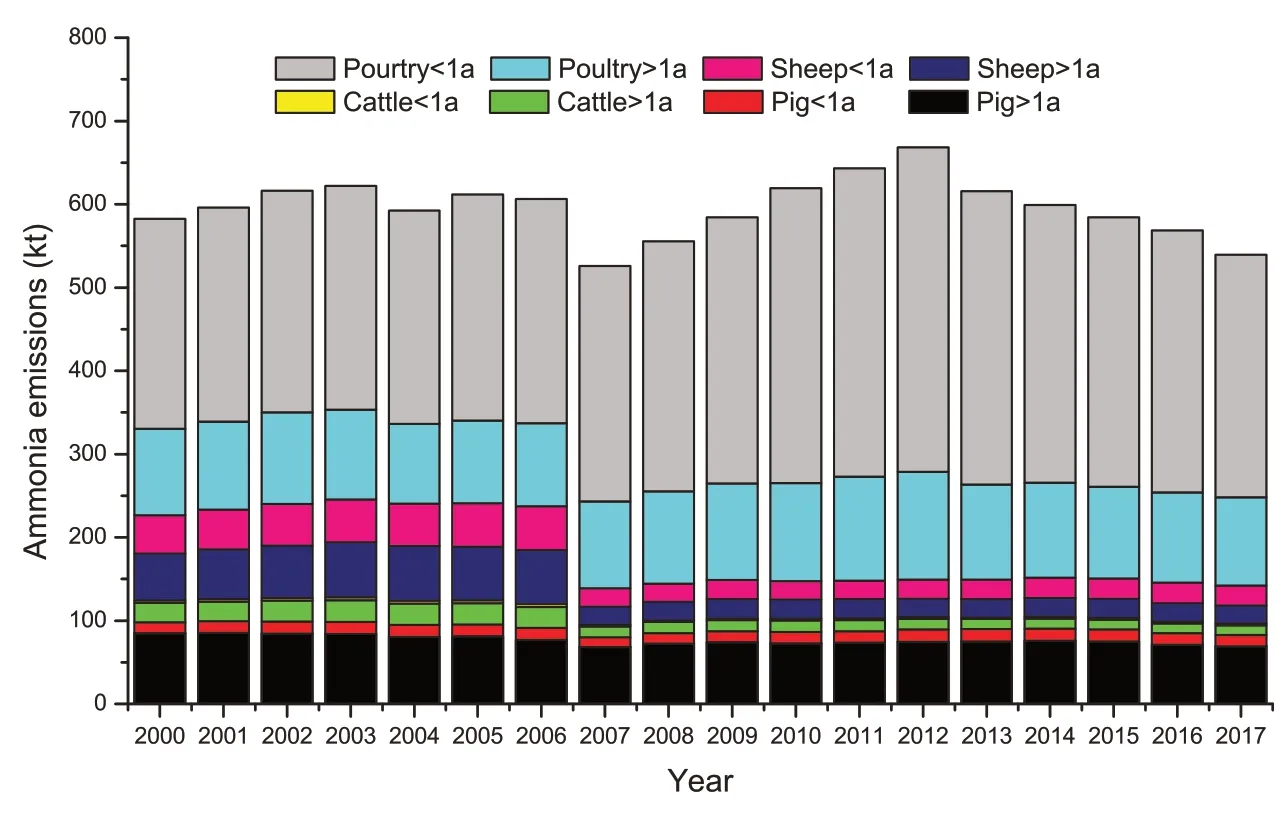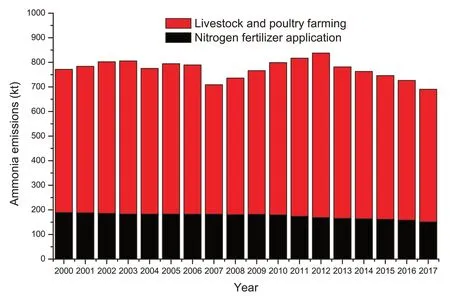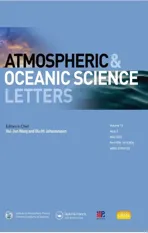Estimation of interannual trends of ammonia emissions from agriculture in Jiangsu Province from 2000 to 2017
2020-10-09HUANGJiayuXIONGRuonanFANGLiLITianlingandSHENWeishou
HUANG Jiayu,XIONG Ruonan,FANG Li,LI Tianling and SHEN Weishou
Collaborative Innovation Centre of Atmospheric Environment and Equipment Technology,Jiangsu Key Laboratory of Atmospheric Environment Monitoring and Pollution Control,School of Environmental Science and Engineering,Nanjing University of Information Science&Technology,Nanjing,Jiangsu,China
ABSTRACT As the only alkaline gas in the atmosphere,ammonia could react with sulfur dioxide and nitrogen oxides to form the secondary particles.A large amount of NH3 in the atmosphere accelerates the rate of formation of fine particles;it therefore plays an important role in haze pollution.Livestock and poultry farming and nitrogen fertilizer application are the two main NH3 emission sources.Jiangsu Province contributes the largest proportion of NH3 emissions from agriculture in key areas of national air pollution control in China.The aims of this study are to investigate NH3 emissions from agriculture in Jiangsu Province using the emissions factor method,and analyze and summarize the characteristics and trends of NH3 emissions from 2000 to 2017.Results show that the NH3 emissions from agriculture in Jiangsu Province from 2000 to 2017 were mainly contributed by livestock and poultry farming (78.08%) and nitrogen fertilizer application (21.92%). Furthermore,a general fluctuation trend of an initial decrease and then an increase, of NH3 emissions from agriculture, could be found from 2000 to 2012, with minimum NH3 emissions in 2007 (708.76 kt yr−1)and maximum emissions in 2012(837.64 kt yr−1);and then a decreasing trend was apparent from 2012(837.64 kt yr−1)to 2017(690.64 kt yr−1).A detailed estimation of the interannual trends and potential measures are also proposed. This study provides a solid theoretical foundation for the development of NH3 emissions control in Jiangsu Province.
KEYWORDS Agricultural source;ammonia emissions;livestock and poultry farming;nitrogen fertilizer application
1. Introduction
Ammonia (NH3) is the only alkaline trace gas with appreciable concentration in the atmosphere (Zeng,Tian,and Pan 2018;Li et al.2019a;Huang et al.2014).It has been confirmed that the sulfur dioxide and nitrogen oxides released by fuel burning and automobile exhausts could convert to sulfuric acid and nitric acid in the atmosphere,which would further react with NH3to form ammonium sulfate and ammonium nitrate.These products become condensation nuclei that can absorb water and combine with other pollutants to form fine particles (Cui et al. 2015; Huang et al. 2019;Torpo et al.2007;Xu et al.2019;Yu et al.2019;Zheng et al. 2015). Therefore, NH3is an important precursor for secondary particles,and is therefore considered as an important component of haze, bringing potential risks to public health (Kim et al. 2019; Pan et al. 2018;Zhang et al.2019;Huang et al.2014).In addition to the haze pollution caused by NH3emissions, after atmospheric deposition,NH3can dissolve in water to cause water eutrophication, destroying aquatic ecosystems(Posch et al.2015;Duan et al.2016;Li et al.2019b).Yet,little is known about the sources and change trends of atmospheric NH3.
Ammonia emissions derive mainly from anthropogenic sources, including agricultural emissions, industrial processes, traffic emissions, waste treatment, and other human activities (Huang et al. 2012; Clarisse et al. 2009;Zeng,Tian,and Pan 2018),among which the largest contributor is agricultural emissions, including two main pathways: nitrogen fertilizer application, and livestock and poultry farming.Of these,nitrogen fertilizer application accounts for approximately 40%, and livestock and poultry farming approximately 50%, of total anthropogenic NH3emissions worldwide (Zhang et al. 2018).Therefore,estimating the characteristics of NH3emissions from agricultural sources, especially from livestock and poultry farming and nitrogen fertilizer application, is imperative for developing NH3reduction strategies for specific regions.
Jiangsu Province is the largest contributor to China’s agricultural NH3emissions in key areas of national air pollution control(Shen,Yu,and Xiang 2018;http://meic model.org/about.html). In addition, Jiangsu Province applies the second largest amount of nitrogen fertilizer in China. Therefore, the aims of this study are to investigate the NH3emissions from agriculture in Jiangsu Province from 2000 to 2017, using the emissions factor method,and analyze and summarize the characteristics and trends of NH3emissions during this period.
2. Materials and methods
2.1. Study area
The study area is Jiangsu Province, located in eastern China, in the lower Yangtze River Delta region. It is a plain area with many lakes and an abundance of water systems. It belongs to the transitional climate from temperate to subtropical. It has moderate rainfall,and the average temperature is between 13°C and 16°C.
2.2. Estimation method
According to the‘Technical Guide for the Preparation of Atmospheric Ammonia Source Emission Inventory’(Song 2014), the most commonly used NH3emissions calculation method at home and abroad —the emissions factor method— was selected in this study. The quantity of NH3emissions is presented by the activity level multiplied by the emissions factor.The calculation can be summarized as:

where i is the source type,j is the year,and Ei,jis the NH3emissions of year j for source i.A is the activity level and EF is the emissions factor.
Activity level refers to the amount of NH3activity in a certain area within a certain period of time. In this study, activity level means the amount of livestock and poultry and the amount of nitrogen fertilizer applied.The emissions factor refers to the amount of NH3emitted per unit of activity level.
2.3. Determination of emissions factor
There are three main methods for determining the emissions factor: actual measurement, model calculation, and literature research. However, the emissions factor is considerably uncertain, due to the complex sources and factors of influence involved in NH3emissions.
For nitrogen fertilizer application sources,the main influencing factors include soil acidity and alkalinity,temperature, nitrogen fertilizer type, and application rate.The types of nitrogen fertilizer commonly used in China are urea, ammonium nitrate, ammonium bicarbonate, thiamine, and other nitrogen fertilizers.According to the ‘Chinese Soil Acid-base Distribution Map’, soil in most parts of Jiangsu is weakly alkaline and alkaline. Based on the ‘Technical Guide for the Preparation of Atmospheric Ammonia Source Emission Inventory’ (Song 2014), the NH3emission factors of nitrogen fertilizer application in alkaline soil at 10°C–20°C are summarized as follows: urea(14.66), ammonium bicarbonate (6.93), ammonium nitrate (0.4), thiamine (1.4), other nitrogen fertilizers (0.23).
For livestock and poultry farming sources, NH3emission factors are mainly affected by temperature,housing, and manure management. As pig, cattle,sheep, and poultry are the top four livestock in Jiangsu Province, the NH3emission factors of these four livestock types were investigated in this study.According to the ‘Technical Guide for the Preparation of Atmospheric Ammonia Source Emission Inventory’(Song 2014), the NH3emission factors of intensive culture and free-range culture at 10–20°C are calculated as follows:pig > 1a(4.21),pig <1a(0.48),cattle >1a(39.24),cattle < 1a(11.84),sheep > 1a(5.48),sheep< 1a(3.34),poultry > 1a(0.36),poultry < 1a(0.04).‘1a’indicates the farming cycle is one year.As there is little difference between these two culture methods, the average values of these two methods were used for calculating the NH3emissions of various livestock and poultry in this study.
2.4. Sources of activity level data
The activity level data in this study mainly include the amount of nitrogen fertilizer applied and the amount of livestock and poultry (pig, cattle, sheep, poultry) in Jiangsu Province. The data for nitrogen fertilizer application come from ‘The China Statistical Yearbook’(National Bureau of Statistics 2001–18).The proportions of urea, ammonium bicarbonate, ammonium nitrate,thiamine,and other nitrogen fertilizers in total nitrogen fertilizer application in Jiangsu Province are 70%, 12%,1.5%, 1.3%, and 15.2%, respectively (Deng and Luo 2018).
The data for livestock and poultry farming come from ‘The China Animal Husbandry and Veterinary Yearbook’ (Editorial Board of China Animal Husbandry and Veterinary Yearbook 2014–18) and‘The China Animal Husbandry Yearbook’ (Editorial Board of China Animal Husbandry and Veterinary Yearbook,2001–13).
3. Results
3.1. Estimation of NH3 emissions from nitrogen fertilizer application
A relatively stable nitrogen fertilizer application rate was found from 2000 to 2009 (Figure 1), with an average of 170–180 kt yr−1, followed by a clear decrease for 2010–17, and the least NH3emissions were found in 2017, at 151.36 kt yr−1, which was a decrease of 16.7%compared to 2009.The maximum rate of NH3emissions over the study period was 189.27 kt yr−1in 2000, the minimum was 151.36 kt yr−1in 2017, and the average was 175.82 kt yr−1.The reason for this trend was that the agriculture commission of Jiangsu Province formulated‘The Action Plan of Zero Growth of Fertilizer Use in Jiangsu Province by 2020’ (http://nynct.jiangsu.gov.cn/art/2015/4/15/art_51418_6178564.html).
In addition, both urea and ammonium bicarbonate were the main sources of NH3emissions,accounting for more than 80% of total NH3emissions from nitrogen fertilizer applications. Stable NH3emissions from both of them (~128.58 kt yr−1for urea and ~22.04 kt yr−1for bicarbonate) were found before 2010. From 2010,a continuous decline can be seen for both of them,and the NH3emissions reached a minimum in 2017,which was mainly because of the decrease in the total nitrogen application rate for the last seven years (Song et al. 2018). The results further indicated that, with the development of techniques and improvement in agricultural production structure, agricultural production gradually requires less fertilizer (Song et al. 2018). By contrast, ammonium nitrate, thiamine, and other nitrogen fertilizers released less NH3,accounting for less than 20%in total.
3.2. Estimation of NH3 emissions from livestock and poultry farming

Figure 1.Ammonia emissions from nitrogen fertilizer application in Jiangsu Province,China,from 2000 to 2017.

Figure 2. Ammonia emissions from livestock and poultry farming in Jiangsu Province, China, from 2000 to 2017. '1a' indicates the farming cycle is one year.
Moderate fluctuations of NH3emissions from livestock and poultry farming were found in the study period(Figure 2). Specifically, there was a fluctuating decline before 2007 and a continuous increase between 2007 and 2012.The lowest value was reached in 2007(525.92 kt yr−1)and a peak of 668.45 kt yr−1was reached in 2012.After 2012,the NH3emissions from livestock and poultry farming from 2000 to 2017 kept falling to 539.28 kt yr−1in 2017, which was a decrease of 19.3% compared to that of 2012. The lowest rate of NH3emissions from livestock and poultry farming from 2000 to 2017 was 525.92 kt yr−1in 2007,the highest was 668.45 kt yr−1in 2012, and the average was 596.12 kt yr−1.The decrease verifies the effect of the government’s policy of developing high-quality, efficient, ecological animal husbandry (http://nynct.jiangsu.gov.cn/art/2012/3/22/art_13251_2573444.html).
Additionally,poultry and pigs contributed the largest fraction of NH3emissions from livestock and poultry,accounting for more than 80%. In comparison, less than 20% of NH3emissions could be found from cattle and sheep,mainly because of their lower feeding rate in Jiangsu Province.
3.3. Estimation of NH3 emissions from agriculture
The estimation results of NH3emissions from agriculture in Jiangsu Province from 2000 to 2017 are summarized in Figure 3. Similar fluctuation trends to the results for livestock and poultry farming can be seen; that is,a decline to a minimum of 708.76 kt yr−1in 2007, then an increase to a maximum of 837.64 kt yr−1in 2012,and finally a fall to 690.64 kt yr−1in 2017.Generally,the NH3emissions fluctuated within 708.76 kt yr−1to 837.64 kt yr−1,with an average of 771.94 kt yr−1.

Figure 3.Annual agricultural ammonia emissions in Jiangsu Province,China,from 2000 to 2017.
4. Discussion
During the study period, NH3emissions from the application of nitrogen fertilizers presented a trend of remaining stable(average of 183 kt yr−1before 2010)followed by a gradual decline (from 179.53 kt yr−1in 2010 to 151.36 kt yr−1in 2017). Among them, urea and ammonium nitrate were the main emission sources, accounting for more than 80% of the NH3emissions from all nitrogen fertilizers.
With regards to the NH3emissions from livestock and poultry farming, moderate fluctuation could be found during this period, with a peak of 668.45 kt yr−1occurring in 2012 and a minimum of 525.92 kt yr−1in 2007.Poultry and pigs were the main sources of NH3emissions from livestock and poultry farming,accounting for 80%–90% in total. In general, agricultural NH3emissions in Jiangsu Province from 2000 to 2017 were mainly composed of those from livestock and poultry farming(78.08%)and nitrogen fertilizer application(21.92%).
As the NH3emissions from livestock and poultry farming and from nitrogen fertilizer application are the two primary pathways of agricultural NH3emissions,it is reasonable to assume that these two contribute all agricultural NH3emissions.The relative contribution of livestock and poultry farming and nitrogen fertilizer application from different regions of China were also compared and discussed in this study. As shown in Table S1, the NH3emissions from livestock and poultry farming contributed 47.21%to 84.89%of the total agricultural NH3emissions,while nitrogen fertilizer application contributed 15.11%to 52.79%, for six different study areas (Dong et al. 2009;Dong,Xing,and Wang 2010;Fang et al.2015;Feng et al.2017;Li and Li 2012;Li et al.2019;Zhang et al.2018;Zhou et al. 2016). The estimation of NH3emissions has shown variability in different studies,meaning it highly depends on the selected emission factors and the different activity level data from region to region. Therefore, estimation work should be carried out on the basis of carefully selecting emission factors and activity level data.
Currently, haze pollution is getting worse in China.Due to the important role of NH3in haze formation,reducing NH3emissions is of great significance for air pollution control.In addition,the NH3emissions profile is greatly different from region to region,so it is necessary to take measurements based on an understanding of the specific characteristics of NH3emissions in the target region. Taking Jiangsu Province for example, on the one hand, due to the large amount of feeding of poultry and pigs, controlling NH3emissions should be paid more attention. On the other hand, because the NH3emissions from urea and ammonium bicarbonate account for about 80% of the nitrogen fertilizer application, the main focus for reducing NH3emissions should be developing alternative fertilizers to urea and bicarbonate.Furthermore, as some factors of influence, such as soil acidity and alkalinity, temperature,nitrogen fertilizer type,application rate,and the kind of crop (i.e. wet or dry crops), could affect NH3emissions from nitrogen fertilizer sources (Xu, Peng, and Yang 2009; Xia et al. 2010), the implementation of an NH3control strategy should also give full consideration to the above factors.
Disclosure statement
No potential conflicts of interest were reported by the authors.
Funding
This study was funded by the National Natural Science Foundation of China [grant numbers 41771291 and 21806080],the Jiangsu Specially-Appointed Professor Program,the Six Talent Peaks Project in Jiangsu Province [grant number NY-083], the Startup Foundation for Introducing Talent of NUIST, and the Innovation and Entrepreneurship Training Program for College Students in Jiangsu Province.
杂志排行
Atmospheric and Oceanic Science Letters的其它文章
- Are typhoon and marine eutrophication the possible missing sources of high dissolved organic nitrogen in wet deposition?
- Spatial and seasonal patterns of atmospheric nitrogen deposition in North China
- Impact of an accidental explosion in Tianjin Port on enhanced atmospheric nitrogen deposition over the Bohai Sea inferred from aerosol nitrate dual isotopes
- Atmospheric nitrogen deposition in Yangtze River Delta:insights gained from the nitrogen content and isotopic composition of the moss Haplocladium microphyllum
- Changes in PM2.5 sensitivity to NOx and NH3 emissions due to a large decrease in SO2 emissions from 2013 to 2018
- Dry deposition of ammonia around paddy fields in the subtropical hilly area in southern China
